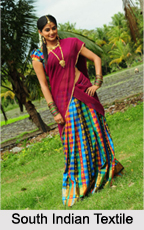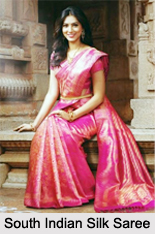 India is admired for its cotton textile since ancient times which still continues to be a flourishing textile center to this day. The tropical lands of Kerala, Tamil Nadu, Karnataka and Andhra Pradesh, has always had its distinctive cultural features. Southern India has undeniably vast textile wealth and abundant weaving regions. There are unlimited kinds of materials found and variety of weaving techniques in South India. At present, southern India can be proud of its traditional weaving techniques that have continued to flourish even after centuries have passed. It has come up as one of the foremost suppliers towards the textile prosperity and exports of the country.
India is admired for its cotton textile since ancient times which still continues to be a flourishing textile center to this day. The tropical lands of Kerala, Tamil Nadu, Karnataka and Andhra Pradesh, has always had its distinctive cultural features. Southern India has undeniably vast textile wealth and abundant weaving regions. There are unlimited kinds of materials found and variety of weaving techniques in South India. At present, southern India can be proud of its traditional weaving techniques that have continued to flourish even after centuries have passed. It has come up as one of the foremost suppliers towards the textile prosperity and exports of the country.
From the typical "Kerala Saree" made from cotton fabric to the classic "Kanchipuram Silk" of Tamil Nadu, from the famous "Mysore Crepe" of Karnataka to the "Himroo or Ikat" of Andhra Pradesh; one cannot stop talking about the varied fabrics and the resultant products obtained from South India.
History of South Indian Textiles
Early documents mention fine muslins and silks from Tamil Nadu. The Mahabharata mentions the textiles of Tamil Nadu. Muslins from Tamil Nadu were presented to Yudhisthira during his coronation. Sangam literary works like the "Silappadikaram" refer to the art of cloth weaving particularly by women. Embroidered cloth with multi-coloured hues was popular with women. Chinese travellers of the 13th century have mentioned that Chola princes wore cotton clothing, which seemed to be the prevailing custom.
Cotton Textile in South India
 The importance of the textile trade can be inferred by the fact that the capital cities of Urayur (Chola), Karur (Chera) and Madurai (Pandya) were situated near cotton growing areas. It is a well-known fact that these towns still have a flourishing textile trade.
The importance of the textile trade can be inferred by the fact that the capital cities of Urayur (Chola), Karur (Chera) and Madurai (Pandya) were situated near cotton growing areas. It is a well-known fact that these towns still have a flourishing textile trade.
In Tamil Nadu cotton weaving is widespread in Kanchipuram, Coimbatore, Salem, Pudukkottai, Madurai and Karur. The Chungidi sarees of Madurai, Kandangi sarees of Chettinadu and the cotton/silk mixtures from Kurainadu are noteworthy. The cottons of Madurai and Salem, particularly the white veshtis with zari borders are known for their sturdy quality. In the 18th century there was Kalamkari trade (pen painting) between Europe and India. The designs were known as "Cheeti", a word from that the European chintz was derived. The art of embroidery was introduced by the Muslims to our people and the craft of lace making by the Portuguese and Dutch. Cotton and silk lace including gold and silver thread work continue to embellish the dresses made here.
Silk Textile in South India
South India has a class of its own in silk sarees. The quality of silk in Tamil Nadu is said to be proverbially excellent with the capacity to endure strenuous washing on a granite stone. The unique characteristic of the Kanchipuram Silk Saree is that the border and pallu are woven separately and then attached to the body of the saree. In addition to Kanchipuram, Kumbakonam and Thanjavur have always been important centres of silk weaving.
Like most crafts of India, weaving and dyeing were hereditary occupations. Even if some of the older traditions of weaving are lost the textile industry continues to thrive in this state. The Weavers Service Centre in Chennai has contributed largely to a textile renaissance, reviving some of the splendid designs from the past as well as incorporating original and contemporary designs.





















